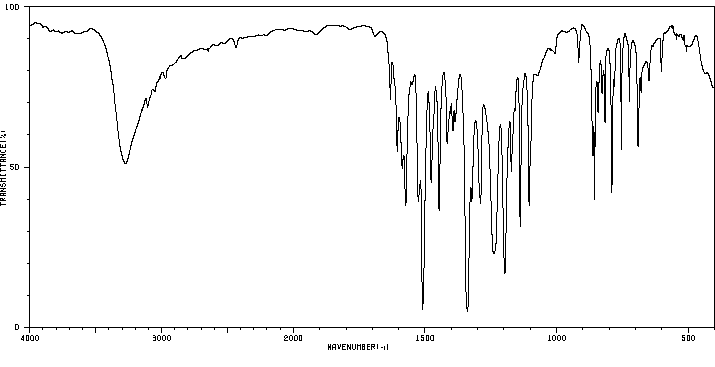5-(4-nitrophenyldiazenyl)-8-hydroxyquinoline | 4341-11-1
中文名称
——
中文别名
——
英文名称
5-(4-nitrophenyldiazenyl)-8-hydroxyquinoline
英文别名
5-(2-(4-nitrophenyl)diazenyl)quinolin-8-ol;5-((4-nitrophenyl)azo)-8-hydroxyquinoline;5-((4-nitrophenyl)diazenyl)quinolin-8-ol;5-(4-nitrophenyiazo)-8-hydroxyquinoline;5-(p-Nitrophenylazo)-8-hydroxyquinoline;5-[(4-nitrophenyl)diazenyl]quinolin-8-ol
CAS
4341-11-1
化学式
C15H10N4O3
mdl
——
分子量
294.269
InChiKey
ALVWYJXOCFNJJJ-UHFFFAOYSA-N
BEILSTEIN
——
EINECS
——
-
物化性质
-
计算性质
-
ADMET
-
安全信息
-
SDS
-
制备方法与用途
-
上下游信息
-
文献信息
-
表征谱图
-
同类化合物
-
相关功能分类
-
相关结构分类
物化性质
-
熔点:281 °C
-
沸点:569.4±45.0 °C(Predicted)
-
密度:1.43±0.1 g/cm3(Predicted)
计算性质
-
辛醇/水分配系数(LogP):3.9
-
重原子数:22
-
可旋转键数:2
-
环数:3.0
-
sp3杂化的碳原子比例:0.0
-
拓扑面积:104
-
氢给体数:1
-
氢受体数:6
反应信息
-
作为反应物:参考文献:名称:Aly, A. A. M.; Hassan, A. M. A.; Soliman, E. M., Indian Journal of Chemistry, Section A: Inorganic, Physical, Theoretical and Analytical, 1990, vol. 29, # 8, p. 811 - 814摘要:DOI:
-
作为产物:描述:8-羟基喹啉 、 4-硝基苯胺 在 potassium hydrogensulfate 、 水 、 sodium nitrite 作用下, 以80%的产率得到5-(4-nitrophenyldiazenyl)-8-hydroxyquinoline参考文献:名称:无溶剂微波照射下的一锅重氮偶联反应摘要:摘要 重氮化和偶联反应在无溶剂微波诱导下在一锅内进行。DOI:10.1080/00397910008087094
文献信息
-
Thermal properties, geometrical structures, antimicrobial activity and DNA binding of supramolecular azo dye complexes作者:A.Z. El-Sonbati、M.A. Diab、A.A. El-Bindary、A.F. Shoair、N.M. BeshryDOI:10.1016/j.molliq.2016.02.043日期:2016.6using Coats–Redfern and Horowitz–Metzger methods. The ligands (HLn) and Ru(III) complexes are screened for their antimicrobial activity against bacterial and fungal species. The tested complexes (1) and (2) have good antibacterial activity against Bacillus cereus and the tested ligands (HL2, HL3 and HL5) have good antifungal activity against Aspergillus niger and also HL5 showed against Alternaria alternata制备5-(4-衍生物苯基偶氮)-8-羟基喹啉(HL n)的Ru(III)配合物,并通过元素分析,IR,UV-可见光谱,1 H和13 C NMR光谱,质谱,X表征射线衍射分析,电导率测量和磁化率测量以及热分析。X射线衍射图谱表明配体(HL 3)具有多晶性质和络合物(2)是完全无定形的。所述配体通过取代来自CN和OH基团的质子而充当通过CN和OH基团配位的二元双齿。摩尔电导率表明Ru(III)络合物本质上是非电解质。光谱表明,所有络合物都是八面体,其中两个氯化物附着在金属离子上。研究了配位体(HL n)和Ru(III)配合物的最佳键长,键角和计算的量子化学参数。分子对接用于预测偶氮染料配体与前列腺癌突变体2q7k激素受体之间的结合。活化热力学参数,例如活化能(E a),焓(ΔH⁎),熵(ΔS⁎))和吉布斯分解的自由能变化(ΔG⁎)是使用Coats–Redfern和Horowitz–Metzger方法计算的。筛选配体(HL
-
基于羟基脱保护反应的喹啉偶氮衍生物传感器及其制备与应用申请人:福建省海凝环保科技有限公司公开号:CN111620904B公开(公告)日:2023-02-24
-
El-Sawi, E.; Moti, F.A.; El-Messary, S., Bulletin des Societes Chimiques Belges, 1985, vol. 94, # 1, p. 69 - 74作者:El-Sawi, E.、Moti, F.A.、El-Messary, S.DOI:——日期:——
-
Das, Pranab J.; Begum, Jesmin, Indian Journal of Chemistry - Section B Organic and Medicinal Chemistry, 2018, p. 355 - 361作者:Das, Pranab J.、Begum, JesminDOI:——日期:——
-
Geometrical structures, thermal, optical and electrical properties of azo quinoline derivatives作者:N.A. El-Ghamaz、A.A. El-Bindary、A.Z. El-Sonbati、N.M. BeshryDOI:10.1016/j.molliq.2015.07.050日期:2015.11Azo quinoline derivatives (AQ(x)) were synthesized by coupling of 8-hydroxyquinoline with aniline derivatives. The optimized bond lengths, bond angles and the quantum chemical parameters for the ligands (AQ(x)) were calculated. The dielectric constants (epsilon(r) and epsilon(i)) and ac conductivity (sigma(ac)) were studied as a function of both temperature and frequency in the temperature range 293-509 K and frequency range 10(2)-10(5) Hz. The thermal activation energies Delta E-1 and Delta E-2 were calculated and found to be in the range of 0.03-0.26 and 0.2-1.31 eV, respectively, depending on the substituent and frequency. The conduction mechanism was investigated for all the derivatives under investigation. The ligands (AQ(1), AQ(2) and AQ(4)) were found to be controlled by correlated barrier hopping model and the ligands (AQ(3) and AQ(5)) were controlled by small polaron tunneling mechanism. The optical absorption properties of the ligands thin films were investigated. The absorption coefficient (alpha) spectra reveals two absorption peaks which are assigned as pi-pi* and n-pi* transitions. The optical energy gap (E-g) was investigated near the absorption edge and found to be in the range of 134-226 and 1.47-1.69 eV for direct and indirect optical transitions, respectively. (C) 2015 Elsevier B.V. All rights reserved.
表征谱图
-
氢谱1HNMR
-
质谱MS
-
碳谱13CNMR
-
红外IR
-
拉曼Raman
-
峰位数据
-
峰位匹配
-
表征信息
同类化合物
(S)-4-(叔丁基)-2-(喹啉-2-基)-4,5-二氢噁唑
(SP-4-1)-二氯双(喹啉)-钯
(E)-2-氰基-3-[5-(2,5-二氯苯基)呋喃-2-基]-N-喹啉-8-基丙-2-烯酰胺
(8α,9S)-(+)-9-氨基-七氢呋喃-6''-醇,值90%
(6,7-二甲氧基-4-(3,4,5-三甲氧基苯基)喹啉)
(1-羟基-5-硝基-8-氧代-8,8-dihydroquinolinium)
黄尿酸 8-甲基醚
麻保沙星EP杂质D
麻保沙星EP杂质B
麻保沙星EP杂质A
麦角腈甲磺酸盐
麦角腈
麦角灵
麦皮星酮
麦特氧特
高铁试剂
高氯酸3-苯基[1,3]噻唑并[3,2-f]5-氮杂菲-4-正离子
马波沙星EP杂质F
马波沙星
马来酸茚达特罗杂质
马来酸茚达特罗
马来酸维吖啶
马来酸来那替尼
马来酸四甲基铵
香草木宁碱
颜料红R-122
颜料红210
颜料红
顺式-苯并(f)喹啉-7,8-二醇-9,10-环氧化物
顺式-(alphaR)-N-(4-氯苯基)-4-(6-氟-4-喹啉基)-alpha-甲基环己烷乙酰胺
非那沙星
非那沙星
青花椒碱
青色素863
雷西莫特
隐花青
阿莫地喹-d10
阿莫地喹
阿莫吡喹N-氧化物
阿美帕利
阿米诺喹
阿立哌唑溴代杂质
阿立哌唑杂质B
阿立哌唑杂质38
阿立哌唑杂质1750
阿立哌唑杂质13
阿立哌唑杂质
阿立哌唑杂质
阿尔马尔
阿加曲班杂质43








